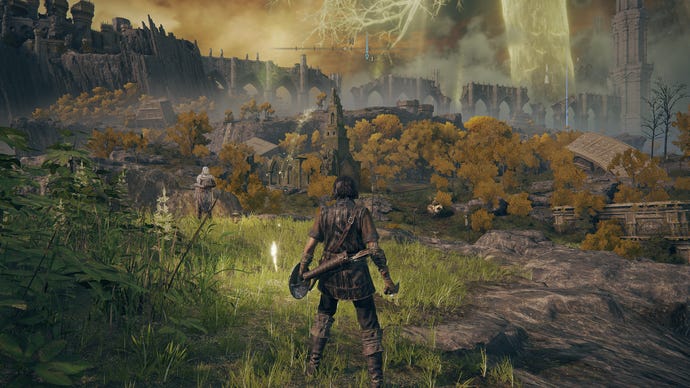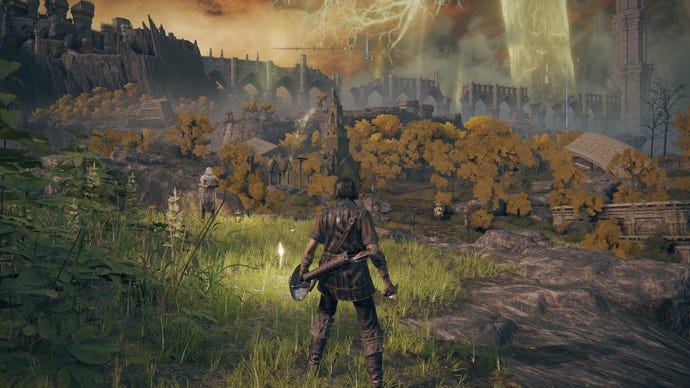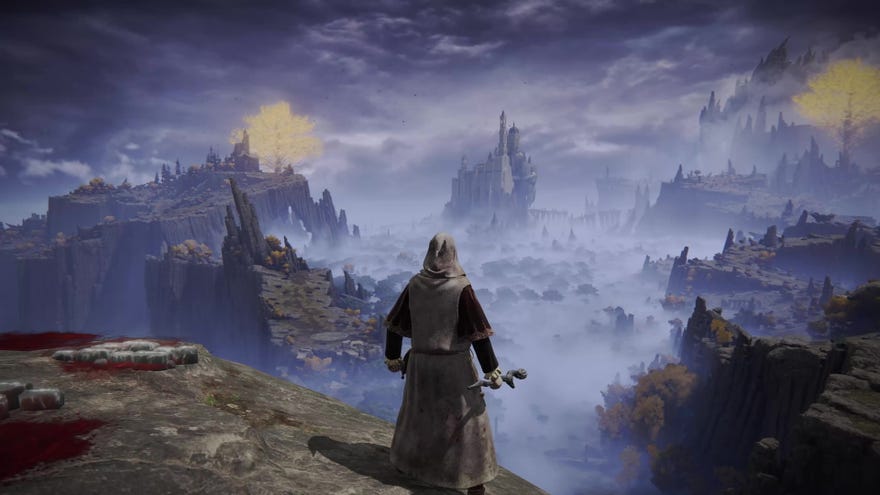Elden Ring PC performance and best settings guide
Reach out and touch grace
Update: Elden Ring is now out and the recipient of a day-one patch, which in part aims to address the stuttering issue described in the performance section below. Sadly, players are still reporting problems, including some that I dodged - like invisible enemies. Oh dear! There are a few possible fixes you can try, though, and I'll keep this guide updated should more official improvements arrive. The original text continues below:
When the Elden Ring system requirements landed on Steam with a dull, disappointing thud, I’d admit to some worry about FromSoftware’s latest would perform on PC. If the minimum recommended graphics card is a GTX 1060, how hard will it be to travel the Lands Between on the highest quality settings? Or at 4K? Would this game kill PCs like it kills player characters?
Nope. As it turns out, Elden Ring will perfectly manageable on a range of hardware, and even if you do want to up the frame rate, there are over a dozen custom graphics options to help you get there. Below, you’ll find guide to Elden Ring’s best settings, based on my performance testing so far. But be warned: Just because it can run decently on PC, doesn’t mean that this is a particularly good PC port.
Like Sekiro: Shadows Die Twice and Dark Souls III before it, Elden Ring launches with a 60fps cap – so anyone who’s invested in one of the best graphics cards or the best gaming monitors will find themselves leashed, at least until enterprising modders can come up with an unofficial patch. And while Elden Ring probably does feel better on a controller than a mouse and keyboard, UI rejigging for the latter remains poor.
For now, then, the highest you can aspire to is a solid 60fps. Let’s start with a reminder of those system requirements, and see how on the money they are.

Elden Ring PC requirements and performance
Elden Ring minimum PC specs
- OS – Windows 10
- CPU – Intel Core i5-8400 / AMD Ryzen 3 3300X
- GPU – Nvidia GeForce GTX 1060 3GB / AMD Radeon RX 580 4GB
- RAM – 12GB
- Storage – 60GB
- DirectX – DirectX 12
Elden Ring recommended PC specs
- OS – Windows 10 / 11
- CPU – Intel Core I7-8700K / AMD Ryzen 5 3600X
- GPU – Nvidia GeForce GTX 1070 / AMD Radeon RX Vega 56
- RAM – 16GB
- Storage – 60GB SSD
- DirectX – DirectX 12
Asking for 12GB of system RAM remains weird to me, but if your PC isn’t quite up these standards, know that you have more wiggle room than such a high minimum spec would suggest. Admittedly, when I tested the GTX 1060 it was a 6GB version – not 3GB – and it was installed in my main test rig, which has a very much above-spec Intel Core i5-11600K and 16GB of RAM. But given this combination averaged 49fps at 1080p using the Maximum graphics preset, having less memory or an older GPU shouldn’t preclude you from clearing the 30fps mark at this resolution. Especially if you drop the quality: the High preset averaged 55fps, while Medium managed 59fps and Low pushed out a near-constant 60fps.
The 6GB GTX 1060 can even handle Elden Ring at 1440p, with performance averages ranging from 37fps at Maximum to 57fps on Low. And having a better GPU isn’t entirely a waste: when I used an RTX 3070 in place of the GTX 1060, Elden Ring averaged a solid 60fps at 1440p and a perfectly playable 51fps at 4K. Again, that's on the Maximum preset.
Still…a 60fps cap? In this day and age? And while it’s not strictly performance-releated, any dedicated mouse and keyboard users can expect to trip up on Elden Ring’s console-leaning interface. Xbox controller buttons adorn the menu and inventory UIs at all times, and what should be basic keyboard input replacements – like Escape taking you back to a previous menu screen – aren’t in place. The wonky workaround, in this specific example, is to right-click to open an additional context menu, then left-click the “Back” option. Which, of course, has a big red controller button icon next to it. Bleh.
I've also experienced occasional frame rate drops and stutters at seemingly random spots around the overworld. Update: you may now see reduced stuttering in the previous problem areas, though players on Steam are still reporting FPS drops, among other issues.

Elden Ring: the best settings to use
Assuming that you’re not faceplanting into that 60fps cap, a trip into Elden Ring’s graphics settings menu could provide the necessary tools to smooth out performance. 14 individual settings can be tweaked one by one, or governed by one of four presets: Maximum, High, Medium and Low. There's no ray tracing to think about yet, though it will be added later in an update.




To leave more headroom for improvements, I’ll be using my 1440p results with the GTX 1060, with the Maximum preset average of 37fps as the control. The High preset, which produced a 41fps average, is about 10% faster; Medium is 30% faster; and Low is 54% faster, coming closest to the limit with 57fps. I think it’s worth avoiding any Low settings as much as possible, though, given how dramatic the step down from Medium is on quality. Lighting and shadows, in particular, don’t do Elden Ring any favours below Medium.
With that in mind, it’s time to go through each setting to see what a more fine-tuned approach can achieve.
Texture Quality: Lowering this from Maximum to Medium only sped up average performance by 1fps, or just under 3%. Even so, it’s one of the more impactful settings to lower piecemeal.
Antialiasing Quality: This also only gave me an extra 1fps when lowered from High to Low. It’s worth doing regardless on higher resolutions, though at 1080p I’d recommend sticking with the higher-quality AA.
SSAO: Dropping ambient occlusion from Maximum to Medium doesn’t harm visual quality too much, and the 3% performance improvement from doing so could be worthwhile.
Depth of Field: Cutting this effect essentially comes down to personal preference, as it won’t help or hurt performance either way.
Motion Blur: As with Depth of Field, changing this won’t impact performance either way, though I felt disabling blur entirely gave Elden Ring more of a crisp, PC-like appearance.
Shadow Quality: Do not lower this in any circumstance. even if you use the High preset, go into the advanced settings and toggle this up to Maximum. The sole reason for this is a ghastly flashing effect on trees, caused by lower-quality leaf shadows suddenly flicking in and out of existence. It’s not as bad on High as it is on Medium or Low, and there’s a modest 3% performance gain from going with Medium, but I can’t say that’s a fair trade. Stick with Maximum to keep these disco trees fully under control.
Lighting Quality: There’s no performance gain to be had from lowering this, so leave it turned up.
Effects Quality: Again, toning this down didn’t yield a single extra frame for me. Then again, there’s very little visible difference between Maximum and Medium quality effects.
Volumetric Quality: Another one to leave up. Volumetric effects contribute generously to Elden Ring’s fantasy aesthetic, and dropping them from Maximum to Medium still saw a 37fps average frame rate.
Reflection Quality: This is yet another setting that appears to have little effect on performance; both at Maximum and Medium, I got the same 37fps.
Water Surface Quality: Even though my benchmark run including trotting through a haunted pond, lowering this setting didn’t improve performance by more than the odd frame. Keep it on High.
Shader Quality: One of the better individual settings to drop, as Medium shaders boosted performance by 3% over Maximum quality. Without harshly cutting into fidelity, too.
Global Illumination Quality: Another whole lotta nuthin’, at least in performance gain terms. Dropping this from Maximum to Medium didn’t grant a single extra FPS.
Grass Quality: By jove, it was the grass all along. Ditching Maximum quality greenery for Medium will be noticeable in more verdant areas, but also produced a relatively strong 5% performance boost in my testing.
There’s not a whole lot to work with here – below 40fps, most of these settings evidently don’t add much to performance when lowered individually, which is unfortunate as that’s the FPS range that needs the most help. Nevertheless, here are the best Elden Ring settings that my testing has arrived at:
- Texture Quality – Medium
- SSAO – Medium
- Shadow Quality - Maximum
- Shader Quality – Medium
- Grass Quality – Medium
- Everything else on High or Maximum
The need to maintain Maximum Shadow Quality is a little frustrating, as it chews into what modest gains are made elsewhere; when I tested this combination with everything else on High, I averaged 41fps, which is no better than simply using the High preset. And yet, because it avoids the flickering tree issue, it is an improvement worth making.


















